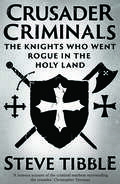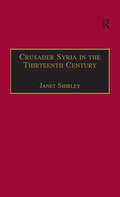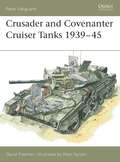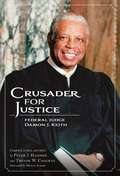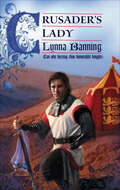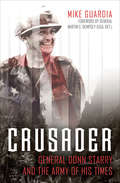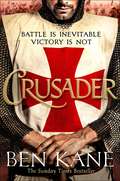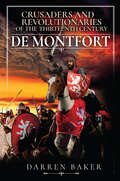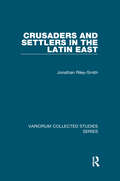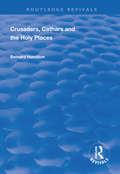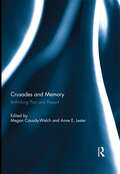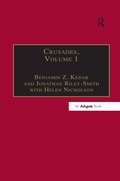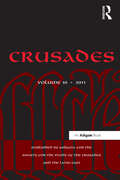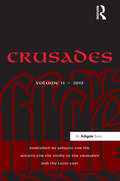- Table View
- List View
Crusader Castles of the Teutonic Knights
by Peter Dennis Stephen TurnbullThe original forced conversion of pagan Livonia, what is now the Baltic states of Latvia and Estonia, was carried out by a military order known as the Brethren of the Sword. In 1236 this order was incorporated into the Teutonic Knights following a catastrophic military defeat. The knights had always consolidated their conquests through networks of castles and fortified places, and the Livonian Chapter of the Teutonic Order built castles of stone. This title covers the developmental and operational history of these fortresses over the length of the Middle Ages. It details how the Baltic fortifications of the Teutonic Knights evolved to reflect the changing nature of siege warfare and the increasing dominance of gunpowder in warfare.From the Trade Paperback edition.
Crusader Criminals: The Knights Who Went Rogue in the Holy Land
by Steve TibbleA vivid new history of the criminal underworld in the medieval Holy Land The religious wars of the crusades are renowned for their military engagements. But the period was witness to brutality beyond the battlefield. More so than any other medieval war zone, the Holy Land was rife with unprecedented levels of criminality and violence. In the first history of its kind, Steve Tibble explores the criminal underbelly of the crusades. From gangsters and bandits to muggers and pirates, Tibble presents extraordinary evidence of an illicit underworld. He shows how the real problem in the region stemmed not from religion but from young men. Dislocated, disinhibited, and present in disturbingly large numbers, they were the propellant that stoked two centuries of unceasing warfare and shocking levels of criminality. Crusader Criminals charts the downward spiral of desensitisation that grew out of the horrors of incessant warfare—and in doing so uncovers some of the most surprising stories of the time.
Crusader Nation: The United States in Peace and the Great War, 1898-1920
by David TraxelIn this absorbing history of the first two decades of the twentieth century, David Traxel paints a vivid picture of a transformative period in the United States, when many remarkable individuals fought to decide which path the country would follow. Victorian restraint was being cast aside by men and women testing social conventions and sexual mores, dancing to dangerous "jazz" music, and expressing themselves through revolutionary forms of art. Traxel traces how these modern ideas were also related to a powerful progressive reform movement that hoped to end the social evils that had accompanied unrestrained industrialization, and he examines the impact of huge waves of European immigration on both the American economy and its social fabric. The struggles to end child labor, win votes for women, rid cities of corrupt political machines, improve public health and education, and prohibit alcohol brought forth a passionate response from millions of Americans who desired both a more efficient and a more compassionate society. Greenwich Village bohemians including Jack Reed, Eugene O'Neill, and Louise Bryant; politicians such as Theodore Roosevelt and Woodrow Wilson; social reformers Margaret Sanger and "Mother" Jones; journalists William Allen White and Lincoln Steffens; and industrialist Henry Ford come alive in these pages. They were Democrats and Republicans, progressives and Socialists, as well as radicals such as the Industrial Workers of the World and anarchists such as Emma Goldman. Combining lively anecdote with historical scholarship, Traxel shows how American crusading continued through World War I, though now focused on "making the world safe for democracy." But by the time the doughboys returned the public was tired of what had come to seem empty rhetoric and unattainable goals. By 1920 the Progressive Era was over, though its laws and effects have lived on. This portrait of early twentieth-century America reveals important qualities of our national character that endure to this day.
Crusader Syria in the Thirteenth Century: The Rothelin Continuation of the History of William of Tyre with Part of the Eracles or Acre Text (Crusade Texts in Translation #5)
by Janet ShirleyThe Old French ’Rothelin’ Continuation of William of Tyre’s Historia provides one of the best contemporary narratives of the history of the crusades and of the Latin Kingdom of Jerusalem in the mid-thirteenth century. Covering the period 1229-61, it has vivid accounts of the disastrous expeditions led by Count Theobald of Champagne (1239-40) and King Louis IX of France (1248-54) as well as of other events in the East. But the text contains far more than this, with a detailed description of Jerusalem itself, songs of protest written by crusaders, and a variety of marvels and adventures, including stories of Alexander the Great, and the poisonous snakes encountered by the Roman army under Cato. This text is here translated into English for the first time, together with a narrative for the same years taken from another Old French Continuation of William of Tyre’s work, part of L’Estoire de Eracles. Both accounts are translated from the Receuil des historiens des croisades: Historiens occidentaux vol. 2 (Paris, 1859). An introduction and full notes make these thirteenth-century events and ideas accessible to students of medieval history and to anyone interested in the lives and patterns of thought of people of that time.
Crusader and Covenanter Cruiser Tanks 1939-45
by Peter Sarson David FletcherThe Covenanter (which never saw active service) and Crusader Cruiser tanks were developed between 1939 and 1940. The Crusader first saw action in the North African desert in June 1941: its speed and sleek design made it a hard target to hit, and the tank was well-respected by the Afrikakorps for its velocity in combat. But its hurried development prior to World War II also made it prone to mechanical failure. This book examines the Covenanter and the many variants of the Crusader tank, detailing the designs, developments and disappointments of these infamous World War II tanks.
Crusader for Justice: Federal Judge Damon J. Keith
by Mitch Albom Peter J. Hammer Trevor W. ColemanThe Honorable Damon J. Keith was appointed to the federal bench in 1967 and has served as a judge on the United States Court of Appeals for the Sixth Circuit since 1977, where he has been an eloquent defender of civil and constitutional rights and a vigorous enforcer of civil rights law. In Crusader for Justice: Federal Judge Damon J. Keith, authors Peter J. Hammer and Trevor W. Coleman presents the first ever biography of native Detroiter Judge Keith, surveying his education, important influences, major cases, and professional and personal commitments. Along the way, the authors consult a host of Keith's notable friends and colleagues, including former White House deputy counsel John Dean, Supreme Court Justice Clarence Thomas, and industrialist Edsel Ford II for this candid and comprehensive volume.Hammer and Coleman trace Keith's early life, from his public school days in Detroit to his time serving in the segregated U.S. army and his law school years at Howard University at the dawn of the Civil Rights era. They reveal how Keith's passion for racial and social justice informed his career, as he became co-chairman of Michigan's first Civil Rights Commission and negotiated the politics of his appointment to the federal judiciary. The authors go on to detail Keith's most famous cases, including the Pontiac Busing and Hamtramck Housing cases, the 1977 Detroit Police affirmative action case, the so-called Keith Case (United States v. U.S. District Court), and the Detroit Free Press v. Ashcroft case in 2002. They also trace Keith's personal commitment to mentoring young black lawyers, provide a candid look behind the scenes at the dynamics and politics of the Sixth Circuit Court of Appeals, and even discuss some of Keith's difficult relationships, for instance with the Detroit NAACP and Supreme Court Justice Clarence Thomas. Judge Keith's forty-five years on the bench offer a unique viewpoint on a tumultuous era of American and legal history. Readers interested in Civil Rights-era law, politics, and personalities will appreciate the portrait of Keith's fortitude and conviction in Crusader for Justice.More information can be found at crusaderforjustice.com
Crusader's Lady
by Lynna BanningJerusalem, 1192, The Third CrusadeSoraya al-Din is a woman bent on revenge. Disguised as a boy, nothing will keep her from her quarry!Marc de Valery is a war-weary knight who has one last duty-to protect King Richard on his perilous journey back to England.As the sun rises over the golden desert, Soraya sets out with Marc. It is the first step on a journey that will take her away from all she knows-across the Mediterranean to the beautiful Italian countryside and over the harsh French Alps. While danger follows close in her footsteps, can she shield her heart against the honorable knight she has sworn to destroy?
Crusader: General Donn Starry and the Army of His Times
by Mike GuardiaThe biography of US Army general Donn Starry, creator of the AirLand Battle doctrine that led to victory in Operation Desert Storm. Donn Starry, one of the most influential commanders of the Vietnam War, went on to become one of the &“intellectual giants&” who reshaped the US Army and, throughout his career, worked to improve training, leadership, and conditions for the men who served under him. Starry was a leading advocate for tank warfare in Vietnam. His recommendations helped shape the American armor position in Southeast Asia and paved the way for his success as commander of the 11th Armored Cavalry during the invasion of Cambodia. As commander of Fort Knox and the US Army Armor School in the 1970s, Starry brought new advances to armor tactics, training, and strategy. Most notably, he created the new &“AirLand Battle&” doctrine, which paved the way for a decisive US victory in the Gulf War. Like most Vietnam-era commanders, Starry&’s legacy has been overshadowed by the controversy surrounding the war itself—but few have had as much of an impact on modern maneuver warfare. In this new biography of Gen. Donn Starry, armor officer Mike Guardia examines the life and work of this pioneering officer using extracts from interviews with veterans and family, as well as from Starry&’s personal papers.
Crusader: The perfect gift for Father’s Day
by Ben Kane'Yet another of history's most brutal and dramatic chapters given the five-star Ben Kane treatment.' Paul FinchKING. POLITICIAN. WARRIOR. CONQUEROR.1189. Richard the Lionheart's long-awaited goal comes true as he is crowned King of England. Setting his own kingdom in order, he prepares to embark on a gruelling crusade to reclaim Jerusalem.With him on every step of the journey is Ferdia, his loyal Irish follower. Together they travel from southern France to Italy, to the kingdom of Sicily and beyond.Finally poised to sail to the Holy Land, Richard finds a bitter two-year-long siege awaiting him. And with it, the iconic Saracen leader responsible for the loss of Jerusalem, Saladin.No one can agree who should fill the empty throne of the Kingdom of Jerusalem and Saladin's huge army shadows Richard's every move. Conditions are brutal, the temperatures boiling, and on the dusty field of Arsuf, the Lionheart and his soldiers face their ultimate test...
Crusader: The second thrilling instalment in the Lionheart series
by Ben Kane'Yet another of history's most brutal and dramatic chapters given the five-star Ben Kane treatment.' Paul FinchKING. POLITICIAN. WARRIOR. CONQUEROR.1189. Richard the Lionheart's long-awaited goal comes true as he is crowned King of England. Setting his own kingdom in order, he prepares to embark on a gruelling crusade to reclaim Jerusalem.With him on every step of the journey is Ferdia, his loyal Irish follower. Together they travel from southern France to Italy, to the kingdom of Sicily and beyond.Finally poised to sail to the Holy Land, Richard finds a bitter two-year-long siege awaiting him. And with it, the iconic Saracen leader responsible for the loss of Jerusalem, Saladin.No one can agree who should fill the empty throne of the Kingdom of Jerusalem and Saladin's huge army shadows Richard's every move. Conditions are brutal, the temperatures boiling, and on the dusty field of Arsuf, the Lionheart and his soldiers face their ultimate test...
Crusaders and Crusading in the Twelfth Century
by Giles ConstableCrusading in the twelfth century was less a series of discrete events than a manifestation of an endemic phenomenon that touched almost every aspect of life at that time. The defense of Christendom and the recovery of the Holy Land were widely-shared objectives. Thousands of men, and not a few women, participated in the crusades, including not only those who took the cross but many others who shared the costs and losses, as well as the triumphs of the crusaders. This volume contains not a narrative account of the crusades in the twelfth century, but a group of studies illustrating many aspects of crusading that are often passed over in narrative histories, including the courses and historiography of the crusades, their background, ideology, and finances, and how they were seen in Europe. Included are revised and updated versions of Giles Constable's classic essays on medieval crusading, along with two major new studies on the cross of the crusaders and the Fourth Crusade, and two excursuses on the terminology of crusading and the numbering of the crusades. They provide an opportunity to meet some individual crusaders, such as Odo Arpinus, whose remarkable career carried him from France to the east and back again, and whose legendary exploits in the Holy Land were recorded in the Old French crusade cycle. Other studies take the reader to the boundaries of Christendom in Spain and Portugal and in eastern Germany, where the campaigns against the Wends formed part of the wider crusading movement. Together they show the range and depth of crusading at that time and its influence on the broader history of the period.
Crusaders and Franks: Studies in the History of the Crusades and the Frankish Levant (Variorum Collected Studies #1059)
by Benjamin Z. KedarWhile research on the crusades tends increasingly to bifurcate into study of the crusade idea and the crusading expeditions, and study of the Frankish states the crusaders established in the Levant, Benjamin Kedar confirms-through the articles reproduced in this latest selection of his articles-his adherence to the school that endeavours to deal with both branches of research. Of the ten studies that deal with the crusading expeditions, one examines the maps that might have been available to the First Crusaders and their Muslim opponents, another discusses in detail the Jerusalem massacre of July 1099 and its place in Western historiography down to our days, a third sheds light on the largely neglected doings of the Fourth Crusaders who decided to sail to Acre rather than to Constantinople, while a fourth exposes unknown features of the well-known sculpture of the returning crusader-most probably Count Hugh I of Vaudémont- who is embracing his wife. Of the ten studies that deal with the Frankish Levant, one proposes a hypothesis on the composition stages of William of Tyre's chronicle, another provides new evidence on the Latin hermits who chose to live in the Frankish states, a third examines the catalogue of the library of the cathedral of Nazareth, while a fourth calls attention to convergences of Eastern Christians, Muslims and Franks in sacred spaces and offers a typology of such events, and a fifth proposes a methodology for the identification of trans-cultural borrowing in the Frankish Levant.
Crusaders and Heretics, Twelfth to Fourteenth Centuries (Variorum Collected Studies)
by Malcolm BarberThese articles seek to understand the attitudes and reactions of medieval society to both external threat and internal dissension, whether real or imagined. The crusaders encompass the Templars and the Knights of St Lazarus, members of military orders committed to the cause of perpetual battle for the faith; more reluctant secular knights urged into the complicated conflicts of Latin Greece by the papacy; and peasant enthusiasts from northern France, ultimately turning their frustration on the clergy and the Jews. Heretics range from Cathars, real opponents of the Church, to the lepers, imaginary subverters of society, allegedly in league with the two other perceived enemies of Western Christendom, the Jews and the Muslims.
Crusaders and Revolutionaries of the Thirteenth Century: De Montfort
by Darren BakerThis family biography charts the rise and fall of the medieval dynasty credited with establishing England’s parliamentary system.Originally from France, the de Montfort family grew to prominence during the 13th century as heroes of the Crusades. Winning lordships around the Mediterranean, they married into the English aristocracy and ascended to an Earlship. Historian Darren Baker explores the family history, dispelling misconceptions and shedding light on its most significant members.Simon de Montfort, a renowned commander of the Albigensian Crusade against the Cathars in France, ascended to the peerage as the 5th Earl of Leicester. But it is his son and namesake who is perhaps the best known. Simon de Montfort, 6th Earl of Leicester, led the Second Baron’s War against King Henry III and established the first parliamentary state in Europe.After Simon’s death at Evesham in 1265, the family falls into decline. Their fate is sealed when their role in a vengeful political murder scandalizes Europe. The lineage ends when Eleanor de Montfort, the last Princess of Wales, dies in childbirth and her daughter is raised as a nun.
Crusaders and Revolutionaries of the Thirteenth Century: De Montfort
by Darren BakerThis family biography charts the rise and fall of the medieval dynasty credited with establishing England’s parliamentary system.Originally from France, the de Montfort family grew to prominence during the 13th century as heroes of the Crusades. Winning lordships around the Mediterranean, they married into the English aristocracy and ascended to an Earlship. Historian Darren Baker explores the family history, dispelling misconceptions and shedding light on its most significant members.Simon de Montfort, a renowned commander of the Albigensian Crusade against the Cathars in France, ascended to the peerage as the 5th Earl of Leicester. But it is his son and namesake who is perhaps the best known. Simon de Montfort, 6th Earl of Leicester, led the Second Baron’s War against King Henry III and established the first parliamentary state in Europe.After Simon’s death at Evesham in 1265, the family falls into decline. Their fate is sealed when their role in a vengeful political murder scandalizes Europe. The lineage ends when Eleanor de Montfort, the last Princess of Wales, dies in childbirth and her daughter is raised as a nun.
Crusaders and Settlers in the Latin East
by Jonathan Riley-SmithThe studies here reflect Jonathan Riley-Smith's work as a historian, which began with research on the history of the military orders, the specific focus of the third section here. Out of this grew the concerns covered in the previous sections: an interest in the political and constitutional history of the kingdom of Jerusalem and the relations of the western settlers with the indigenous population of Palestine and Syria; the theory of crusading, involving research on theology and canon law, and the rôle of the popes as preachers, and at the same time detailed consideration of the responses of lay men and women to the ideas that were being presented to them. The two final papers explore some of the implications of crusading ideology and mythology in the modern world.
Crusaders in the Courts: How a Dedicated Band of Lawyers Fought for the Civil Rights Revolution
by Jack GreenbergStory of the NAACP Legal Defense Fund
Crusaders, Cathars and the Holy Places (Routledge Revivals #Vol. Cs 656)
by Bernard HamiltonFirst published in 1999, this volume emerged as part of the Collected Studies series and features studies authored by Bernard Hamilton over a period of twenty years, all of which deal with relations between Western Europe and the neighbouring civilizations in the Eastern Mediterranean during the 12th and 13th centuries. The first set examines the kind of society which developed in the Crusader States (including three essays on women and Queens), and the attitude of western settlers to the Byzantine Empire, eastern Christian churches and the Islamic world. Further essays deal with the impact on Western Europe of Christian dualist heresy which had its roots in the Balkans and Armenia, and perhaps ultimately in Persia. The final group centres around the Holy Places, whose liberation was the raison d’etre of the crusade movement. They examine how the Western Church administered these shrines, the way in which they shaped western piety during the time of crusader rule, and how the cult of the Holy Places developed in the Western Church after they had been recaptured by Islam. Each article’s original citation information is included, along with the original page numbers and pagination.
Crusaders, Gangsters, and Whiskey: Prohibition in Memphis
by Patrick O’DanielProhibition, with all its crime, corruption, and cultural upheaval, ran its course after thirteen years in most of the rest of the country—but not in Memphis, where it lasted thirty years. Patrick O’Daniel takes a fresh look at those responsible for the rise and fall of Prohibition, its effect on Memphis, and the impact events in the city made on the rest of the state and country. Prohibition remains perhaps the most important issue to affect Memphis after the Civil War. It affected politics, religion, crime, the economy, and health, along with race and class. In Memphis, bootlegging bore a particular character shaped by its urban environment and the rural background of the city’s inhabitants. Religious fundamentalists and the Ku Klux Klan supported Prohibition, while the rebellious youth of the Jazz Age fought against it. Poor and working-class people took the brunt of Prohibition, while the wealthy skirted the law. Like the War on Drugs today, African Americans, immigrants, and poor whites made easy targets for law enforcement due to their lack of resources and effective legal counsel. Based on news reports and documents, O’Daniel’s lively account distills long-forgotten gangsters, criminal organizations, and crusaders whose actions shaped the character of Memphis well into the twentieth century.
Crusaders: The Epic History of the Wars for the Holy Lands
by Dan JonesA major new history of the Crusades with an unprecedented wide scope, told in a tableau of portraits of people on all sides of the wars, from the New York Times bestselling author of The Templars.For more than one thousand years, Christians and Muslims lived side by side, sometimes at peace and sometimes at war. When Christian armies seized Jerusalem in 1099, they began the most notorious period of conflict between the two religions. Depending on who you ask, the fall of the holy city was either an inspiring legend or the greatest of horrors. In Crusaders, Dan Jones interrogates the many sides of the larger story, charting a deeply human and avowedly pluralist path through the crusading era.Expanding the usual timeframe, Jones looks to the roots of Christian-Muslim relations in the eighth century and tracks the influence of crusading to present day. He widens the geographical focus to far-flung regions home to so-called enemies of the Church, including Spain, North Africa, southern France, and the Baltic states. By telling intimate stories of individual journeys, Jones illuminates these centuries of war not only from the perspective of popes and kings, but from Arab-Sicilian poets, Byzantine princesses, Sunni scholars, Shi'ite viziers, Mamluk slave soldiers, Mongol chieftains, and barefoot friars. Crusading remains a rallying call to this day, but its role in the popular imagination ignores the cooperation and complicated coexistence that were just as much a feature of the period as warfare. The age-old relationships between faith, conquest, wealth, power, and trade meant that crusading was not only about fighting for the glory of God, but also, among other earthly reasons, about gold. In this richly dramatic narrative that gives voice to sources usually pushed to the margins, Dan Jones has written an authoritative survey of the holy wars with global scope and human focus.
Crusades and Memory: Rethinking Past and Present
by Megan Cassidy-Welch and Anne E. LesterCrusading was a religious movement involving papal authorization, the incentive of remission of sins, pious motivation on behalf of the individual, and the justification of holy war. Much recent historiography in this area has focused on resolving the questions of what a crusade was, and why people went on them. But crusading became a cultural and social phenomenon that changed across time and geographical space. In turn, crusading was shaped by the ways specific crusades and their participants were remembered in specific historical contexts. Moreover, crusade memory had profound effects on the cultivation of family lineage, kinship ties, national and regional identity, and religious orthodoxy. Integrating memory into crusades scholarship thus offers new ways of exploring the aftermath of war, the construction of cultural and social memory, the role of women and families in this process, and the crusading movement itself.This book explores memory as a methodological means of understanding the crusades. It engages with theories of communicative memory, social and cultural memory, war commemoration, and historical processes of remembering. Contributions explore the variety of cultural forms used in cultivating crusade memory. Material, visual, liturgical and textual objects are all reflective of crusade culture and the process of crafting its memory, and the analysis of such sources is of particular interest. This publication furthers new trends in crusade scholarship which understand the crusades as a broad religious movement that called upon and developed within a wider cultural framework than previously acknowledged.This book was originally published as a special issue of the Journal of Medieval History.
Crusades – Medieval Worlds in Conflict
by Thomas F. Madden James L. Naus Vincent RyanThese essays, selected from papers presented at the International Symposium on Crusade Studies in February 2006, represent a stimulating cross-section of this vibrant field. Organized under the rubric of "medieval worlds" the studies in this volume demonstrate the broad interdisciplinary spectrum of modern crusade studies, extending far beyond the battlefield into the conflict and occasional cooperation between the diverse cultures and faiths of the Mediterranean. Although the crusades were a product of medieval Europe, they provide a backdrop against which medieval worlds can be observed to come into both contact and collision. The range of studies in this volume includes subjects such as Muslim and Christian understandings of their wars within their own intellectual and artistic perspectives, as well as the development of memory and definition of crusading in both the East and West. A section on the Crusades and the Byzantine world examines the intersection of western and eastern Christian attitudes and agendas and how they played out - particularly in the Aegean and Asia Minor. The book concludes with three studies on the crusader king, Louis IX, examining not only his two crusades in new ways, but also the role of the crusade in his later sanctification.
Crusades: Volume 1 (Crusades #13)
by Jonathan Riley-Smith Jonathan Phillips Benjamin Z. KedarCrusades covers seven hundred years from the First Crusade (1095-1102) to the fall of Malta (1798) and draws together scholars working on theatres of war, their home fronts and settlements from the Baltic to Africa and from Spain to the Near East and on theology, law, literature, art, numismatics and economic, social, political and military history. Routledge publishes this journal for The Society for the Study of the Crusades and the Latin East. Particular attention is given to the publication of historical sources in all relevant languages - narrative, homiletic and documentary - in trustworthy editions, but studies and interpretative essays are welcomed too. Crusades appears in both print and online editions. This first edition of the journal includes contributions from Jonathan Riley-Smith refecting on the number of knights who participated in the First Crusade and the number of casualties and Peter W. Edbury on Fiefs and Vassals in the Kingdom of Jerusalem: from the Twelfth Century to the Thirteenth.
Crusades: Volume 10 (Crusades)
by Jonathan Riley-Smith Jonathan Phillips Benjamin Z. KedarCrusades covers seven hundred years from the First Crusade (1095-1102) to the fall of Malta (1798) and draws together scholars working on theatres of war, their home fronts and settlements from the Baltic to Africa and from Spain to the Near East and on theology, law, literature, art, numismatics and economic, social, political and military history. Routledge publishes this journal for The Society for the Study of the Crusades and the Latin East. Particular attention is given to the publication of historical sources in all relevant languages - narrative, homiletic and documentary - in trustworthy editions, but studies and interpretative essays are welcomed too. Crusades appears in both print and online editions.
Crusades: Volume 11 (Crusades)
by Jonathan Riley-Smith Jonathan Phillips Benjamin Z. KedarCrusades covers seven hundred years from the First Crusade (1095-1102) to the fall of Malta (1798) and draws together scholars working on theatres of war, their home fronts and settlements from the Baltic to Africa and from Spain to the Near East and on theology, law, literature, art, numismatics and economic, social, political and military history. Routledge publishes this journal for The Society for the Study of the Crusades and the Latin East. Particular attention is given to the publication of historical sources in all relevant languages - narrative, homiletic and documentary - in trustworthy editions, but studies and interpretative essays are welcomed too. Crusades appears in both print and online editions.

